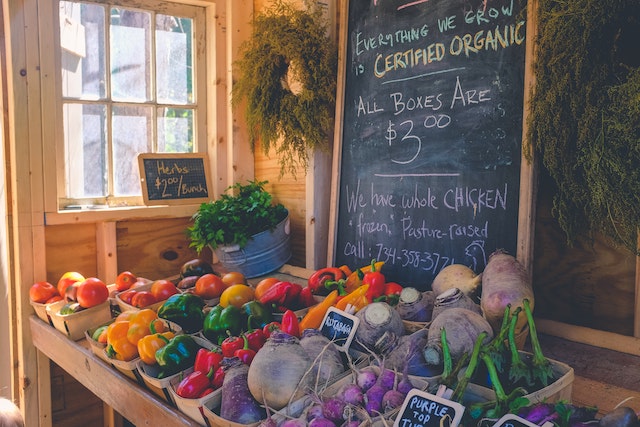Unlock the Magic in Your Story Now
Get the Free 20 questions to Ask Before Launching Your Idea workbook when you sign up for occasional updates.
Get the Free 20 questions to Ask Before Launching Your Idea workbook when you sign up for occasional updates.
Expect The Good
filed in Meaningful Work, Strategy, Worldview

There is no way of knowing if the organic vegetables I bought today were grown without pesticides. But I trust that they were.
When I order gluten-free bread for a friend, I trust my baker has used the right flour.
I believe the chocolate inside the bar labelled ‘fair trade’ is ethically produced.
Every day we rely on millions of people we’ve never met to tell the truth and do the right thing. And they do.
Our culture and our society depend on us expecting the good. And we do.
Image by Neonbrand
Share this article
The Case For Storytelling
filed in Story Skills

Every day during the current global pandemic we’ve watched the numbers go up.
We’ve listened to our leaders tell us about the number of active cases.
We’ve seen unemployment figures published in news articles.
We’ve heard about the numbers of lives lost.
Our scientists, experts and leaders keep us informed to convince us of the seriousness of the situation. They need to gain our trust and influence us to act in the interest of the collective good. Without a doubt, we need the rigour of data. But we also need the persuasive power of storytelling to spread these life-saving health messages and measures.
Storytelling is our most persuasive technology.
Hearing a story about one person’s experience has more impact on us than all the data in the world. We humans are hardwired to be influenced by stories. And yet, we are rarely trained in the important skill of storytelling.
Every one of us needs to learn these story skills if we are to inspire change. I want our activists, educators, leaders and scientists to become better storytellers. And I want you to be your most influential and inspiring self so that you can use your stories for good.
Last year Seth Godin and I launched The Story Skills Workshop to help more people like you to harness the power of storytelling. Since then, 5,000 people have taken the workshop. We’re proud of how we’ve helped people like you to become better storytellers.
You can sign up for details about when the workshop opens again here.
We each have the power to tell better stories and create the future we want to see.
Image by Raj
Share this article
When Things Catch On
filed in Story Skills, Strategy, Success

When things catch on, we often assume that their success happened en masse and out of the blue. One day an idea is invisible to us, the next it’s everywhere.
The truth about ideas that fly is that they gain traction in increments.
One story, one believer, one advocate at a time.
We earn the right to speak to more people by delighting the first one.
Image by Ketan Rajput
Share this article
Stronger Together
filed in Meaningful Work, Strategy

It’s the day before Melbourne cafes close again under reinstated lockdown restrictions. The owner of the Italian restaurant that opened in January is heart sore. We get chatting as I’m paying the bill. He explains that due to then pandemic they’ve been able to have patrons dine in for only nine of the twenty-four weeks they’ve been open. Most of his Italian staff have returned home, and he’s doing his best to support and keep his local team in work.
The business has transitioned to takeaway only and offers grocery boxes for delivery. What’s most impressive is how the owner is building customer loyalty while caring for his team during this difficult time. When the restrictions hit, he sat with each staff member to find out how many hours work they needed to pay their bills. The team members with second jobs worked less and offered extra hours to those who needed more.
Overwhelmingly what we’re seeing in these challenging times in the hospitality sector and beyond among both businesses and customers is a renewed sense of mutual appreciation.
Small businesses are doing everything they can to adapt and serve. And the community is doing what it can to sustain local businesses. If the past few months have reminded us of anything, it’s how dependent we are on each other. That symbiosis has the power to make us stronger.
We’re not just in this together. We’re better because we’re together.
Image by Zhanjiang Chen
Share this article
Trusted Over Time
filed in Meaningful Work, News, Strategy, Success

We often hear it said that it’s hard to stand out in an increasingly competitive world.
Maybe you can’t be the biggest, fastest or cheapest in your field. But there are plenty of ways to differentiate and make a mark. First among them is by being trusted over time.
Make promises you intend to keep. Keep them.
Image by Zdeněk Macháček
Share this article
The Will And The Way
filed in Meaningful Work, Worldview
 My grandmother was fond of repeating the proverb: ‘Where there’s a will there’s a way.’ She’d say it to encourage us to try.
My grandmother was fond of repeating the proverb: ‘Where there’s a will there’s a way.’ She’d say it to encourage us to try.
I don’t think I’ve fully appreciated its power until now.
Seeing how our communities and local businesses have adapted to the pandemic restrictions is proof of how innovative and resilient we are.
If someone had told you six months ago: I’ve lost count of the number of times in recent weeks I’ve heard these words in conversation.
There are so many things that none of us could have predicted at the start of this year. Probably most surprising and wonderous of all is how we can and do adapt in service of the collective good.
When it matters we find the way.
Image by Mika Baumeister
Share this article
On Influence
filed in Story Skills, Success, Worldview

Many of us go through life feeling powerless to change things. After all, not everyone has leadership status or power conferred upon them. We sometimes believe that influence is a top-down construct—that we can have the most influence from a position of authority.
Let’s challenge that assumption.
Think about someone whose impact helped change how you see the world.
My uncle Larry was that person for me. He was the youngest of my grandmother’s eleven children—born with a genetic disorder that caused many health issues throughout his life and his premature death. Larry never knew his father, who died as he lay sleeping in bed next to him and my grandmother when he was a year old.
When he was thirteen, Larry’s headmaster told him he was too tall to be at school and instructed him to leave. That was the end of his formal education. It was hard for him to find manual work because he was often sick. He learned to love reading and was curious about the world. He chain-smoked and spent hours tinkering with big motorbikes.
Larry introduced me to the library when I was seven. I grew up in a house with no books, so joining the library changed everything. Larry was the one who unlocked the magic of books for me. He taught me to play chess and ride a bike without training wheels. When I went with him to his outpatient hospital appointments, we sat in the canteen over lukewarm tea and Club Milk biscuits watching doctors and nurses coming and going in the corridors. ‘You could be a doctor or a nurse one day,’ Larry said. He was the person who encouraged me to expect the most for and from myself.
I’m willing to bet the people who’ve had an impact on you rarely had the authority to do so. Each one of us, regardless of our status, can choose to be an encourager—an agent of possibility for others.
Image by Seth Stoll
Share this article
Raising The Bar

When I was a teenager, I joined the local athletic club. I’d never been much of a runner, but since I went to an all-girls school, the draw of the athletic club where boys hung out was abundantly clear. It was time to dust off my running shoes.
The worst thing about contemplating long-distance running wasn’t starting—it was not knowing if I had the stamina to finish. I was never sure if a stitch or a cramp would stop me from completing the requisite number of laps around the track. So, I opted-out and choose to take part in the distances and events I knew I could at least safely complete.
On the one hand, that sounds like a decent strategy. No sense in starting something if you’re not sure you can succeed when there are other, safer options open to you. But if we only did the things we were sure would work, we’d end up limiting our potential and stifling our growth.
No matter what project we’re embarking on, it’s tempting to lower the bar so we can be certain of a successful outcome before we begin. Alternatively, we can choose to find joy in the effort of exceeding our expectations.
Image by Markus Spiske
Share this article
That Certain Something

A new local grocery store around the corner from us finally opened its doors last weekend. For weeks we’ve been pressing our noses to the window as the new tenants swept the floor and stocked the shelves ready for the big day. The previous grocer stocked only organic produce, operated a juice bar and sold health supplements. He did well for many years until he expanded to two more locations that didn’t gain traction and eventually had to close all three.
Our new grocer tells us he doesn’t sell organic produce but he plans to stock more convenience food in the coming weeks. We’re not sure how his offering will be different enough from that of the two big-name supermarkets just four hundred metres walk from his door.
His store doesn’t sell anything customers can’t buy cheaper in another shop. He can’t compete on proximity, product range or price, so he needs to offer customers something they won’t get at the supermarket. It’s not yet clear what that ‘certain something’ is.
The people in our neighbourhood will try to support this new local store. They will pop in for a forgotten ingredient at 5 pm on a Tuesday evening or buy fresh flowers to cheer up a room at the weekend. But there won’t be enough of us buying sufficient volume to keep the lights on, and the shelves stocked.
Whatever we make, sell or serve, the question we must ask ourselves isn’t—if we build it, will they come? The harder and often scarier question to answer is—why would they come?
It sounds obvious, but we must give the people we want serve enough reasons to support us. Listing those reasons is a good place to start.
Image by Mehrad Vosoughi
Share this article
A Good Job
filed in Meaningful Work

George is in his seventies. His hearing has deteriorated over the years, but he’s reluctant to wear a hearing aid. He hates missing out on parts of conversations and often feels isolated because he can’t hear what’s going on. He’s embarrassed about his disability. But he feels self-conscious about wearing a clunky, visible hearing aid that he thinks makes him look older.
So, when a sales letter arrives in the mail describing how he feels every day as he struggling to take part in conversations, George keeps reading. The letter goes on to give details about a new inexpensive (under $300), yet small hearing aid that will solve all his problems. He phones the clinic straight away to make an appointment.
The following week he arrives at the clinic to have his hearing tested. The technician immediately tells him the $300 aid won’t be suitable for him. Of course, there are other options. He shows George two sample hearing aids. One model is $6,000—the other is $3,000. George can’t afford the more expensive one. And he’s not sure about committing to paying ten times what he believed the hearing aid would cost him—especially since there is no way to test this model on-site that day.
But the technician who is also the salesperson prides himself on being good at his job. Half an hour later George finds himself sitting on a bench outside the shop clutching a receipt for the deposit on the $3,000 hearing aid that will arrive next week. He’s still not sure if it will work for him or if he wants it at all.
The salesperson thinks he got a good result. He’ll see a boost in his commissions at the end of the month. The store manager will likely congratulate him on a job well done. He did close the sale after all.
Many of the hard metrics we use to assess if we’ve done a good job are crude and unreliable. Often the best measure of work we can be proud of are the soft metrics that are overlooked and harder to measure.
How we get results is as important as the results themselves.
Image by Nick Cooper